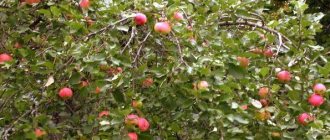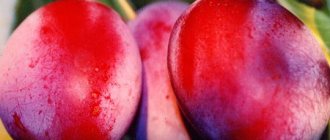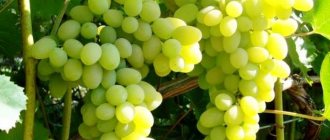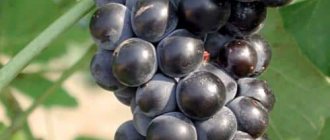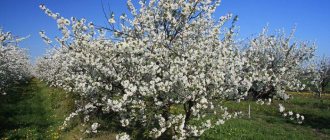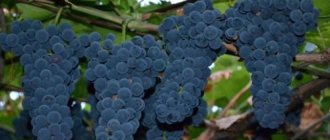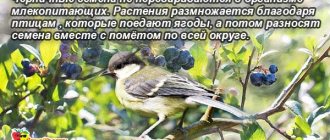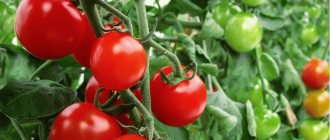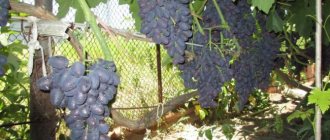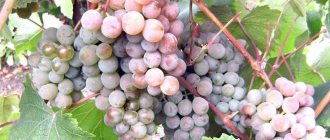Vladimir grapes. Grape plantations in Vladimir
In the middle of the 20th century, the city of Vladimir was famous not only for its special cherries, but also for its local grape variety
The list of popular surnames, which includes the names Kuznetsov, Ivanov, Petrov and Sidorov, in the Vladimir region can be safely supplemented with the surname Vinogradov. Which, at first glance, is quite strange, because according to the logic of things, the Vinogradovs should live in large numbers where there is a lot of sun and warmth, where tasty and healthy grapes grow, for example, in the Kuban. By the same logic, in the Vladimir region the Yablokovs, Vishnevs, and, in extreme cases, the Oblepikhovs and Slivins should prevail. But those who think that grapes are not ours, not Vladimir’s, are cruelly mistaken.
In the 1950s in the city of Vladimir, on Sacco and Vanzetti Street, in the garden behind house No. 24 there was a notable vineyard. More than 300 bushes basked under the stingy northern sun. Each vine ripened at least 28 bunches of selected berries of the varieties “Russian Concord”, “White Chasselas”, “Hansen Seedling”, “Madeleine Angevin”, “Ranniy Malengre” and “Mino Franc”.
Alexey Ivanovich Kireev was engaged in viticulture on Sacco and Vanzetti Street. The no longer young Michurin resident set an ambitious goal - to promote this southern plant to the north and achieve harvests on an industrial scale.
In 1950, a breeder planted 22 varieties of grapes, only 14 varieties took root, and another 8 died from frost. There are 6 promising early varieties left in the Vladimir vineyard. Kireev himself developed another completely new variety and called it “Vladimir grapes.” This plant could survive the winter in our climatic conditions without any shelter.
In addition to grapes, the Vladimir Michurin resident’s garden grew mulberries, figs, walnuts, hazelnuts, persimmons, and asparagus. Kireev grew early “seedless” tomatoes and cucumbers, which ripened 20-25 days earlier than ordinary plants.
The authorities of the city of Vladimir groomed and cherished the amateur breeder. The executive committee allocated a special plot of land to Kireev, on which at least 600 grape bushes could be grown, and installed a water supply system in his garden.
The newspaper “Prazyv” wrote in 1953:
“Kireev builds all his work on a strictly scientific basis, based on the teachings of I.V. Michurin. Keeps records, diaries, and makes numerous experiments. The gardener has a rich library, which contains almost everything written about grapes and methods of growing them. He is preparing a work about the northern “Vladimir grapes” for publication. Agile, tireless, he is on his feet all day, always in trouble. Alexey Ivanovich spends most of his time in the garden, caring for plants. His schoolboy grandson Yura helps him in all his work.”
Unfortunately, only newspaper notes have survived from our days, but not a trace of the vineyard itself has disappeared.
Forum statistics
207036 Messages in 1634 Topics from 5593 Users. Last user: Amaya Last message: “Let's talk about the weather in Vash...” ( Today at 07:52:22 ) Latest messages on the forum.
Now on the forum
33 Guests, 14 Users
Users in the last 15 minutes: gardener, marlin64, Nikolay 2, rambo, Vasily 53, ALEX, Elvira2017, 77volt, Evgeniy52, kvg, ElenkaF, sergei, Ser, Evgeniy 163 [Blocked] [Section Moderator] [Forum Moderator]
Maximum online today: 100 . All-time maximum online: 2758 (28 July 2021, 17:22:51)
Users who visited the forum in the last 24 hours
Total: 295
(Visible: 294, Hidden: 1) 1963, Kenig, gardener, marlin64, Nikolay 2, Vasily 53, rambo, ALEX, 77volt, Elvira2017, kvg, Evgeniy52, ElenkaF, sergei, Ser, Evgeniy 163, Lyubov S., Erem, Polyanina Ekaterina, kosmos, Yura, GALINA ANOKHINA, DorontsovPeter, ZaycevAS, Alex65, 64nikolay64, Vova Kapran, zsb, Polina77, spotlight, Mikhail Alekseevich, Svetla777, Tikhii, Marshal, Nikolay S., therapist, Liza, Capricorn, lomakin1969, Alexander Vl ., Andrey76, Slavka, Mikhail77, Tatyana B, Cherkessk, Eugene, leonidych, vladimirM, yotmast, mers, Serg1707, SNovichek, hanter64, znakomij, Alexander K, Vardan, Sergey Fer, Anatoly Sivkov, Alexey V, Ilya 77, Andrey Gladilin , Tatyana A., Belgorodets, in Astrakhan, Oksana Kopp, sem_en, Vladimir 153, skier, Igor Viktorovich, slavalimon, Primorets, OlgaOs, SANYCH, 31rus, mystic69, Andrey Tsvetkov, Buba, igor222, Elena Z, vlad51, Nikolay Rex, Sergey 1965, Vladimir Buturlakin, DSW, psv1960, Dmitry 77, Vasily V., Vyacheslav03, Natalia Nikolaevna, Sergey Tashchiyan, Igor Sergeevich, alexsandr, Pioneer, nicson7, Elena Aleshchenko, Alexander-ask-34, Verona, Igor F., Taker , Henry, Yuri72, L.A.P., Gaivoronsky Yuri, Sergeevich, Sergei Chistokletov, Svetlana Streletskaya, Galinka, Alexey Deminov, Naumov Igor, Vyacheslav136, Gloomy, Katrin, AndSanych, Mikhno Alexander, Ded31, Filippov Oleg, Vladimir ++ , Lydia58, ALEXANDER BRYANSKY, Vladimir-kanevskaya, DIL, Amber7394, Marina Protasova, TITOVA LYUBOV, Linx, alexander66, Natalya M, Mikhail Fesenko, Amaya, Alexander71, Boris 1952, tsv, Maximilian, 25nata35, nadia, Igor_K, Alexander Kolesnikov , Ivan Levin, Pitko, weather forecaster, eSAa, cecet71, atseton, Alexander Smirnov, Vladimir Kostochkin, Vladimir Berdnikov, Gocha, pioneer-2, LeXa_KoT, Sergey 61, Sergey Yuryev, alexss, Skif, Vladimir Kovba, dayton, Yuri Semyonov, N. A. Sokolov, Pavlentiy, Sa-shura, Volgogradka, Dmitry Anatolyevich, Grandfather Igor, Andrey Lis, Bublichenko Alexander M, Marina Krymskaya, stenlly2010, irahelm, Vyacheslav Vladimirovich, Vladimir Shilov, Aprel, Badaev Dmitry, gheo55, y_fed, Yagodka, Valentina Ivanovna, Kryn, oleg9f, DED2, Svetlana Korotina, Oleg Ivanovich brought in, Eduard., santra, L2k2m7n, Alexander48, Viknik, Andrey 31, m2d, Valery Rastorguev, Soshnin Yura, Amateur gardener, Galina, Vasily1111, Salex, Sergey Ko, Ramiz, Victor_, potap05, Yuri 36, VitalySD, Inna161, Vladimir Shcherbinin, Valerie, niy1, cfibr, Andrey68, kulol3, thanatos, Serzh1978, Realist, Artur53, max2008-01, LOZA, AlexanderD, Ded Young, Natasha, Zayac, ketch , Rita, alx-74, Iv Iv, Alexander150, Igor K, Vasily Viktorovich, VeraNiK, kdm57, Veniaminovich, Boris Sokolyansky, , vikbublik, neposny, Evgen, Victoria Aleksandrovna, Serezha 64, Wintel, Airbone, teri, Sergey Lomonosov, Khramov , serzhinio, Leonty Yarygin, Irina O., Nadezhda Grig, netolya, Saisan, Alexey Agryzkov, Vadi, Zinaida, Vadim, Alexander Taganrog, Sergey Sukhonos, Snezhinets, evgen_26, nau_63, Masha_sadovod, Gennady163, krasnovlad1, Alexander Zinoviev, Roman Fedorovich, TIS, Alexey Sergeevich, arnyusha, Zheka, Nurtas, kradievska, nick041, Valentina Medvedeva, Sergey43, Andrey S., Nikolay Lipunov, Mst, Vertuoz2, Vladimir VS, NatalyaMed, freesia, Kinna, Mikhail Michurinsk, alekcsan1, VALERY TAMB, Sasha57, MikhAf, Y_Azer, Andrey Beribesov, hunter1955, nut lover, Keys, Ivan Shmelev, Pestle, anton_slash, Nadymchanka, Sergey 31, Volgar, Pavel 64, Tatyana Volzh, Elektronik_t
Growing grapes in the northern regions. Grapes in the north description
Grapes are an exceptionally productive vine, a symbol of fertility and prosperity, which has attracted farmers at all times. Not only in the Southern, but also in the Central regions of Russia, they have long tried to “tame” this culture, to make it local. But the advance to the north was hampered not so much by reduced winter hardiness (they learned to cover the vines for the winter), but by the insufficient length of the growing season and the lack of heat in summer, necessary for the ripening of berries. However, even if the harvest managed to ripen, the quality and sugar content of the berries did not meet the requirements, being significantly inferior to southern grapes.
In recent years, the development of northern viticulture has received a new impetus associated with the emergence of new varieties for the northern zone and the improvement of agricultural techniques. For super-early interspecific varieties and hybrids, 100 - 110 days of growing season are enough for maturation with an average daily temperature in mid-summer of only +18 degrees, and for the formation of flower buds the daytime temperature should be +21...+23 degrees. To create warmer microconditions, grapes are planted along the southern wall of buildings. It is even safer to use summer film greenhouses for this. In areas with unstable snow cover and soils of light mechanical composition, the vine is covered with earth for the winter. If the snow cover is stable, this is not necessary. After autumn pruning, the vine is tied and pinned to the ground, after placing a few bush branches under it. Some branches or spruce branches are also placed on top and covered with roofing felt or other material. Such a shelter is practically no worse than an earthen one, but is less labor-intensive and allows you to avoid overheating the vine.
Grapes of northern latitudes. Russia grape
At the “Day of Winegrowers of the Non-Black Earth Region” holiday on September 30, 2011, uncovered Russian grape varieties were shown, which gained from 22% to 28% sugar in field conditions at the 55th parallel of northern latitude, in Smolensk, which is undoubtedly a unique achievement. It was found that varietal characteristics and original agricultural technology, which involves the construction of a deep (60-70 cm) drainage ditch, allowing the soil in the root zone to quickly warm up in the spring and cool down in the fall, are of decisive importance for the high accumulation of sugar. To accumulate sugar, these varieties do not require elevated temperatures; the physiologically optimal 20-24 degrees is enough for them.
Large-scale continuation of the work begun by the outstanding breeder A.I. Potapenko using modern technologies will make it possible in the next 5 years to obtain varieties of Russian grapes in which the sugar content will reach 30%, with a period before ripening of 90 days and frost resistance of the buds of 37-42 degrees. Northern grapes, grown in a harsh climate, have increased tonic and medicinal properties and are an environmentally friendly product.
There are already varieties with frost resistance of buds up to –40°, roots up to –20°, requiring less heat and growing on thin soils without shelter for the winter and watering in the summer, but with low quality berries. Our frosty, long winter destroys many pathogens and pests, allowing us to produce environmentally friendly grapes for baby food. Increased duration of sunshine contributes to the accumulation of sugar sufficient for winemaking. The costs of watering and chemical treatments are eliminated, therefore the cost of grape materials is several times lower than in the Caucasus. The average grape yield in Smolensk is 100-200 c/ha, with a physiological maximum of 500 c/ha. This will make it possible to make a profit on abandoned, unsuitable, hilly soils and ravines. The productive period of the vineyard is up to 30 years.
Diseases and pests
Most grape varieties grown in the Leningrad region are resistant to diseases. Their possibility should not be ruled out. Therefore, prevention of mildew, oidium, and gray rot is necessary. The topic of diseases is especially relevant for greenhouse grapes. To prevent fungal diseases, control the humidity level, spray the soil and shoots with fungicides.
Dangerous pests include:
- spider mite;
- leaf roller (grape);
- grape itch;
- phylloxera.
Fungicides are also used against them throughout the season. It is possible and necessary to engage in viticulture in the climate of the Leningrad region, despite the short summer, and obtain decent harvests of berries. Success is achieved by gardeners who select the right varieties and take into account the peculiarities of the local climate when growing grapes.
Grape of the north northern lemon. Chaenomeles - northern lemon
Chaenomeles, or Japanese quince, is often called the northern lemon because of its sour fruits with a high content of vitamin C. And in appearance, many varieties resemble lemons. And the color is the same yellow.
Chaenomeles is native to the mountains of Japan. The residents of our central region also liked Japanese knotweed, mainly due to its high frost resistance. Chaenomeles can withstand frosts down to -30º C, and due to the snow cover it can survive the harshest winter. After all, its bushes rarely grow above one meter. Therefore, Japanese quince has every chance of becoming a real resident of the north, where it is valued not only as an ornamental shrub, but also for its vitamin fruits.
Chaenomeles blooms in May, and blooms for a very long time and profusely. Its flowers are especially beautiful - bright orange-red, with a glossy shine, somewhat reminiscent of rosehip flowers.
Buy a couple for divorce
If you decide to plant Japanese quince to obtain vitamin fruits, then plant at least two plants, since without a pollinator you will not get them at all, or there will only be a couple of them on the bush.
When the quince flowers, it produces egg-sized fruits that ripen in late September-October. Then they will acquire a yellow color and a bright aroma unique to quince. “Apples” on Japanese quince taste sour and astringent.
What to do with the harvest
The fruits of Japanese quince make excellent aromatic jam and syrup, which can be made according to the following recipe: the fruits are cut into pieces, placed in a basin or jars and sprinkled with sugar. After a day, a syrup of excellent taste and aroma is formed, which can be stored in the basement or refrigerator for almost a whole year. This syrup is rich in vitamins and is considered an excellent addition to winter teas.
Where to plant
The ideal option is when three Japanese quinces grow on the site. Plant them at a distance of 1.5 m from each other. It is better to choose an open and sunny place for shrubs. The root system of Chaenomeles is powerful, the roots go deep into the soil and respond well to watering and fertilizing.
What to feed
Chaenomeles is fed for the first time at the end of winter or at the very beginning of spring, scattering mineral fertilizers on the snow under the bushes.
During the summer, feed a couple of more times with mullein solution (1 liter of infusion per bucket of water).
Immediately after harvesting, the soil under the bushes should be dug up, after adding a bucket of well-rotted manure.
Reproduction
Chinese quince is propagated by seeds, which are sown in the fall. Over the winter they undergo natural stratification, and by next autumn the seedlings reach a height of 40 cm. After three years, Japanese quince will give its first harvest, and after five years it will be possible to harvest 5 kg per bush.
Quince is also propagated by green cuttings, lignified cuttings and horizontal layering. True, these methods are quite complex and do not always take root.
About pruning
Chaenomeles, like most berry bushes, is pruned in the spring. Old branches that do not bear fruit are removed, leaving well-developed shoots of different ages. An adult fruiting bush should have no more than 15 of them.
OUR HELP
Chaenomeles have long been used by landscape designers in the design of flower beds, lawns and rocky hills. It looks great both in single plantings and in composition with coniferous and deciduous plants. It is also used as a low hedge. It is considered an excellent honey plant.

